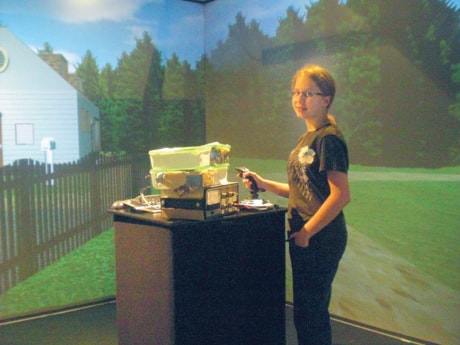Virtual reality may seem all the more real in the future, with not only people’s sense of sight and hearing engaged, but also their sense of smell.
A high school student from Elnora is part of the cutting edge research, having just worked on a project at the University of Alberta known as Smell-O-Vision.
Ashley Brown, a Grade 12 student at Delburne Centralized School and the cyber school North-Star Christian Academy, was one of 60 high school students accepted into the Women in Scholarship, Engineering, Science and Technology (WISEST) summer research program at the U of A.
The 17-year-old spent the past six weeks creating a virtual world for people to explore. The world had fruits like strawberries, bananas, oranges, apples and lemons, with smells attached that blew through a device as people approached the items in the virtual world.
A person can navigate the virtual world by moving a joystick or using the arrow keys on the computer. The scents come from special oils in boxes with fans that run air over them.
Brown’s research may serve a playful purpose — but also a practical one.
Brown explained that there are people who in laymen’s terms have “smell blindness.” Basically it means they can’t smell things that could be critical to their survival, such as smoke when a fire starts in their home.
Brown said the Smell-O-Vision machine she worked on during the summer could train people to smell scents such as smoke.
The device could also be used in rehabilitation, with people coming back from traumatic situations using certain scents to trigger their memories and help them get over events.
Brown worked on the project with U of A supervisors Fraser Anderson and Michelle Annett, who came up with the idea and will continue on with the project. They hope to talk to the Glenrose Rehabilitation Hospital, which is installing a CAREN system, that will have a 3-D and motion capture in a dome shape. The researchers would like to find a way to add scent to this to help people rehabilitate from traumatic experiences.
Brown, who first started working with computers at age eight, hopes to continue with computers once she graduates from high school, with plans to study computer science.
She said there are so many uses for computers in health fields, architecture and building virtual worlds. At the moment, she hasn’t narrowed her options to the gaming world, robotics or computers for medical uses.
“Computers have so much potential,” Brown said. “Computers bridge the gaps between the sciences. You can use computers for medical reasons and for rehabilitation or you can use them to create designs in engineering. You can use them to show all the specimens under microscopes in biology. There are so many uses for them. There are endless possibilities.”
sobrien@www.reddeeradvocate.com
